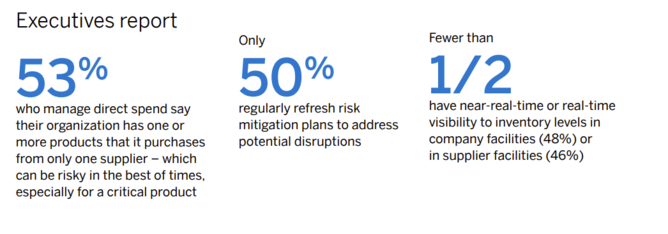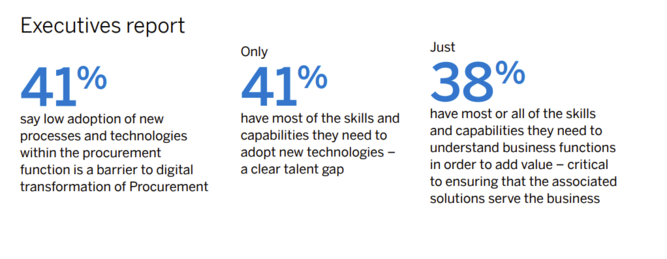SAP: Making a case for digital transformation in procurement

With staggering figures such as 77% of organisations being unable to gain a clear view of their overall spend in real-time, and only 50% can quickly find alternative sources of supply, the vulnerabilities and fragilities of supply chains are being exposed, particularly in the last couple of years.
While many organisations have ramped up their efforts to digitise their business for greater visibility and efficiency, many procurement functions continue to operate with a technology deficit, lacking many of the basics.
“This makes it difficult to mitigate risk and ensure continuity of supply, let alone work on strategic initiatives such as co-innovating with suppliers,” commented SAP.
So how can you make the business case for investing in digital transformation? CPOs should ask themselves five key questions:
1. How well is supplier risk managed?
Years of supplier optimisation and cost reductions have led to many organisations being over-reliant on a select few suppliers that could be halfway around the world. The last few years have shown how critical procurement is, and the risk in operating in this way, particularly when coupled with poor visibility.
SAP recommends organisations enable end-to-end visibility into the supplier base, as well as real-time capabilities and a dynamic marketplace.

2. Still using manual processes?
“Manual processes are a significant barrier to visibility, effective management, operational efficiency and organisational agility,” warned SAP.
Those that automate processes are in a much better position to be agile in their response to disruption. Automation also frees up the capacity of talent to focus on more strategic and value-adding activities.
SAP recommends that organisations digitise and simplify all processes into one single cloud platform.

3. What is the adoption rate of procurement solutions?
While technology is a great enabler, the benefits can only truly be seen if people use them. “If Procurement isn’t fully using its own processes and technologies, how can the rest of the organisation be expected to?,” said SAP.
A key aspect of successful adoption is ease of use. Solutions need to be intuitive, with a guide experience. “By improving the buying experience, companies will drive greater adoption and greater compliance,” said SAP.
SAP recommends that organisations drive visibility, control, and compliance with a smart and simple guided buying experience, as well as automate the payables process and supplier collaboration.

4. Are decisions data-driven?
Despite actionable, data-driven insights being an essential aspect of business, many procurement teams continue to rely on antiquated, unintegrated technology, and manual processes when it comes to compiling and analysing data.
“Accelerating adoption of predictive analytics, AI and machine learning would help Procurement make more informed decisions, mitigate risk and more effectively support stakeholders,” said SAP.
SAP recommends that organisations gain greater insights into all spend and suppliers, in a reliable and comprehensive database to enable real-time information sharing.

5. What is known about external labour?
Often organisations will turn to contingent works and service providers to meet their goals, SAP reports that the ‘external workforce’ accounts for 42% of workforce spend. Despite this, many procurement teams lack visibility into these workers creating a significant risk for an organisation and decreasing the value they provide.
SAP recommends gaining visibility into these works and actively managing the external workforce, to improve ROI and reduce risks. Standard records in a single platform can also help with effective management.

To read the full SAP report, click here
- Alberta Health Services’ SPO joins P&SC LIVE New YorkProcurement Strategy
- Michael Hourihan, General Mills CPO joins P&SC LIVE New YorkSustainable Sourcing
- Janelle Orozco, CPO at Kraft Heinz joins P&SC LIVE New YorkDigital Procurement
- Top 100 Women 2024: Barbara Kubicki, Wells Fargo – No. 3Procurement Strategy






